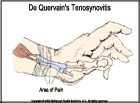
De Quervain's Tenosynovitis
What is de Quervain's tenosynovitis?
De Quervain's tenosynovitis is a painful condition affecting the tendons located on the thumb side of your wrist. A tendon is a strong band of tissue that attaches muscle to bone. A sheath, or covering, surrounds the tendons that go to your thumb. Tenosynovitis is an irritation of this sheath.
How does it occur?
De Quervain's tenosynovitis usually occurs from overusing your thumb or wrist, especially in activities that move your thumb directly away from your wrist such as skiing or hammering.
What are the symptoms?
Symptoms may include:
- pain when you move your thumb or wrist
- pain when you make a fist
- swelling and tenderness on the thumb side of your wrist
- feeling or hearing creaking as the tendon slides through its sheath.
How is it diagnosed?
Your health care provider will examine your wrist and thumb and find the areas that are tender and painful to move. An x-ray may be taken to be sure you don't have a broken bone.
How is it treated?
The initial treatment for de Quervain's tenosynovitis is a splint that will cover your wrist and thumb. It is important that you protect your thumb and wrist from activities that worsen your pain.
Treatment may also include:
- placing an ice pack on your thumb and wrist for 20 to 30 minutes every 3 or 4 hours until the pain goes away
- doing ice massage for 5 to 10 minutes several times a day
- taking an anti-inflammatory medication such as ibuprofen
- having an injection of a medication like cortisone.
You will be given rehabilitation exercises to help speed your recovery and prevent the problem from returning.
When can I return to my sport or activity?
The goal of rehabilitation is to return you to your sport or activity as soon as is safely possible. If you return too soon you may worsen your injury, which could lead to permanent damage. Everyone recovers from injury at a different rate. Return to your activity will be determined by how soon your wrist recovers, not by how many days or weeks it has been since your injury occurred. In general, the longer you have symptoms before you start treatment, the longer it will take to get better.
You may return to your sport or activity when it is no longer painful to move your thumb or wrist. You may need to do activities wearing a supportive splint until you no longer have symptoms.
How can I prevent de Quervain's tenosynovitis?
Avoiding activities that overuse your thumb or wrist may prevent de Quervain's tenosynovitis.

